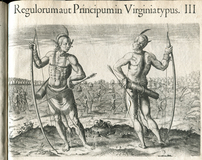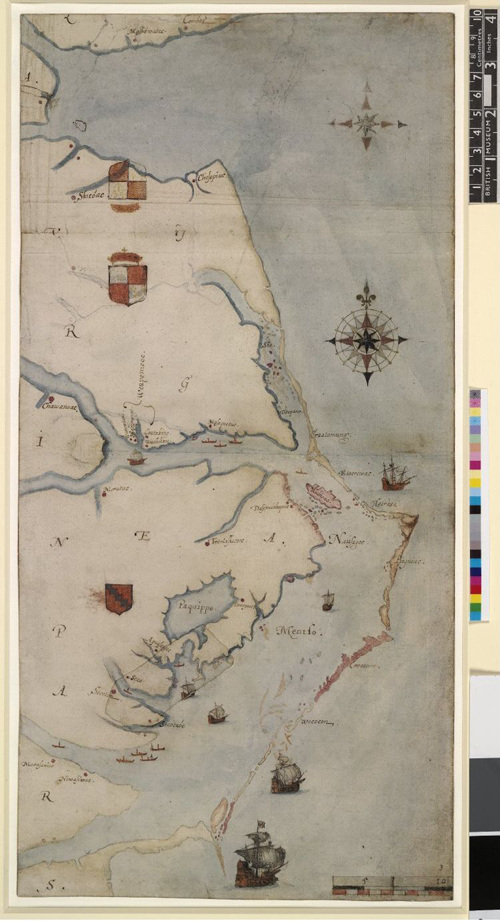 So yet another person has found the Lost Colony. Our pal Lawson would have snorted if he had shown up in modern times and heard the mysterious tale of the Lost Colony. You know the story: 1587, Roanoke Island. Over the previous couple years a very spotty history of English attempts to plant their very first colony ever has resulted in mostly death and disaster, but Sir Walter Raleigh sends a ship with another 115 or so colonists, ostensibly to go to the Chesapeake Bay in the Virginia colony, which then encompasses the whole coast of North America as far south as Cape Fear. They stop at Roanoke to see what has become of the previous garrison of soldiers left there a couple years before. Nobody's home, but instead of heading up to the Chesapeake the mission commander pretty much tosses them off the boat: you're colonizing here and that's it. So they do -- John White, artist, mapmaker, and friend to the Queen, is in charge as governor, and they start trying to make sense of the place. White had been part of an earlier expedition, in 1585, on which he created a map astonishing even today in its accuracy and beauty. He also made a series of drawings that were the first ever of the coastal Indians, introducing them to English society. |
 See? See? There they are -- right there!
See? See? There they are -- right there! So White goes home -- and runs, inconveniently, into the Spanish Armada, or anyhow England's war with same in 1588. England wins, which is good for England, but that and the privateering that goes along with such things keeps everybody busy until 1590, at which point another ships heads off to Roanoke to see what's what.
Not much, that's what. Nobody left, and the word "Croatoan" carved into a post of the abandoned fort. No sign of a struggle. Also, "CRO" carved into a tree. Croatoan was the name of the nearby island we now call Hatteras, and the Croatan peoples there seem to have been largely friendly to the colonists. When White returned in 1590, in fact, he was overjoyed to see the carved words, believing they meant the colonists had joined the Croatans. They had plainly left without duress, and though the empty site of their previous camp was disturbed, White concluded this was the work of the unfriendly Roanoke Indians after the colonists had left.
Unfortunately, a storm was blowing up, and the sailors weren't willing to go to Hatteras to see what had happened, and that was it for that investigation. So no further information came from the colony until 1607, when the Jamestown colony in Virginia settled, and then everything got kinda wacky. John Smith -- yes, that John Smith -- heard when he was once captured that some of the colonists remained alive, and he even included locations on a map, eventually taken from him, that showed where he believed they were. He was told by others, though, that the colonists had been slaughtered. Other theories involve the colonists moving in with various other tribes -- the Lumbee have long held that some of their members descend from the Lost Colony -- or moving inland, with the discovery that a spot on the White map covered an image of an inland fort causing something of a ruckus in 2012.
Anyhow, an entire industry of Lost Colony theories now occupies a certain species of usually amateur historical thinker, so it would have delighted Lawson when, this very week, researchers from the Lost Colony Center for Science and Research announced that they believed they knew exactly what had happened. The colonists had decamped, headed inland, and set up shop in an area called Beechland -- it's now in the Alligator River National Wildlife Refuge -- and began farming sassafras, an important early export crop of the colonies, already interesting to Europeans by this time because they believed it cured syphillis, that earlier American export. Sir Francis Drake brought some sassafras to England in 1586, with the remainder of the previous Roanoke colony, and Sir Walter Raleigh did export it as early as 1602, so the idea that sassafras was behind the colony makes sense. Still, indeed an important export (second only to tobacco in the 1650s), but the theory has a few holes. How the colonists crossed 4.5 miles of open water to get to the mainland, for one, though certainly Indians could have helped. How they knew about where to begin a plantation is another. A third is why they would have carved a note saying they were going in the exact opposite direction on a tree for White to find.
The answer is the same one it usually is. Fred Willard, director of the Lost Colony Center, says the entire undertaking was an enterprise to farm and export sassafras, supported by everyone from Raleigh to Queen Elizabeth herself. Secrecy was at the core: "It was a huge, huge conspiracy," he says. Isn't it always?
Anyhow, I even bring this up because Lawson would have found the very notion of a "lost" colony laughable. He lived in a fracture zone -- where multiple cultures were coming together and mixing, with good and bad results. People lived and traded, fought and died, shared food and diseases, had children. Things got messy. Lawson actually addressed the entire Lost Colony business with barely a shrug, when talking about the Hatteras Indians.
"The first Discovery and Settlement of this Country was by the Procurement of Sir Walter Raleigh, in Conjunction with some Publick-spirited Gentlemen of that Age, under the Protection of Queen Elizabeth; for which Reason it was then named Virginia,being begun on that Part called Ronoak-Island, where the Ruins of a Fort are to be seen at this day, as well as some old EnglishCoins which have been lately found; and a Brass-Gun, a Powder-Horn, and one small Quarter deck-Gun, made of Iron Staves, and hoop'd with the same Metal; which Method of making Guns might very probably be made use of in those Days, for the Convenience of Infant-Colonies.
A farther Confirmation of this we have from the Hatteras Indians, who either then lived on Ronoak-Island, or much frequented it. These tell us, that several of their Ancestors were white People, and could talk in a Book, as we do; the Truth of which is confirm'd by gray Eyes being found frequently amongst these Indians, and no others. They value themselves extremely for their Affinity to the English, and are ready to do them all friendly Offices. It is probable, that this Settlement miscarry'd for want of timely Supplies from England; or thro' the Treachery of the Natives, for we may reasonably suppose that the English were forced to cohabit with them, for Relief and Conversation; and that in process of Time, they conform'd themselves to the Manners of theirIndian Relations. And thus we see, how apt Humane Nature is to degenerate.
I cannot forbear inserting here, a pleasant Story that passes for an uncontested Truth amongst the Inhabitants of this Place; which is, that the Ship which brought the first Colonies, does often appear amongst them, under Sail, in a gallant Posture, which they call Sir Walter Raleigh's Ship; And the truth of this has been affirm'd to me, by Men of the best Credit in the Country."
"The English were forced to cohabit with them, for Relief and Conversation; and that in process of Time, they conform'd themselves to the Manners of their Indian Relations." To me, in one sentence, that solves the entire mystery of the Lost Colony. You put a hundred or so people on a speck of an island off the coast of an entire continent, inhabited by people who already know you're willing to kill them if it strikes your fancy. Then you go off and leave them for three years -- and you act surprised when they're not exactly where you left them? Then they leave a note telling you where they went, but you wait another decade or two before you get there to see what's what. And then you act like it's a big mystery that somehow your hundred or so people have pretty much melted into the landscape. What did you expect?
Anyhow, it is forever a delight to see where Lawson's observations lead, and how important they are to everybody trying to understand the early days of the European and North American cultures mixing up.
I'm going back on the road tomorrow. I'll let you know if I find any sassafras or any gray-eyed Indians.

 RSS Feed
RSS Feed